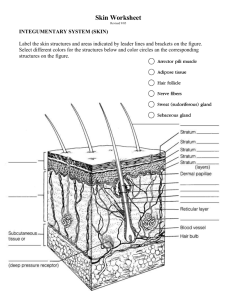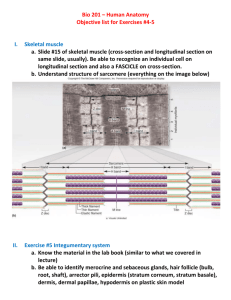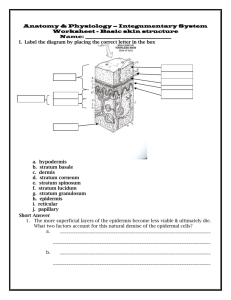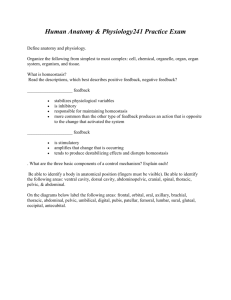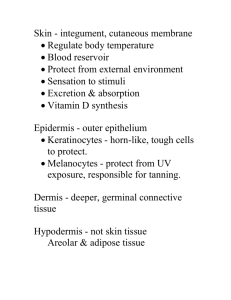Exam I BIOS 160 Anatomy and Physiology Name
advertisement
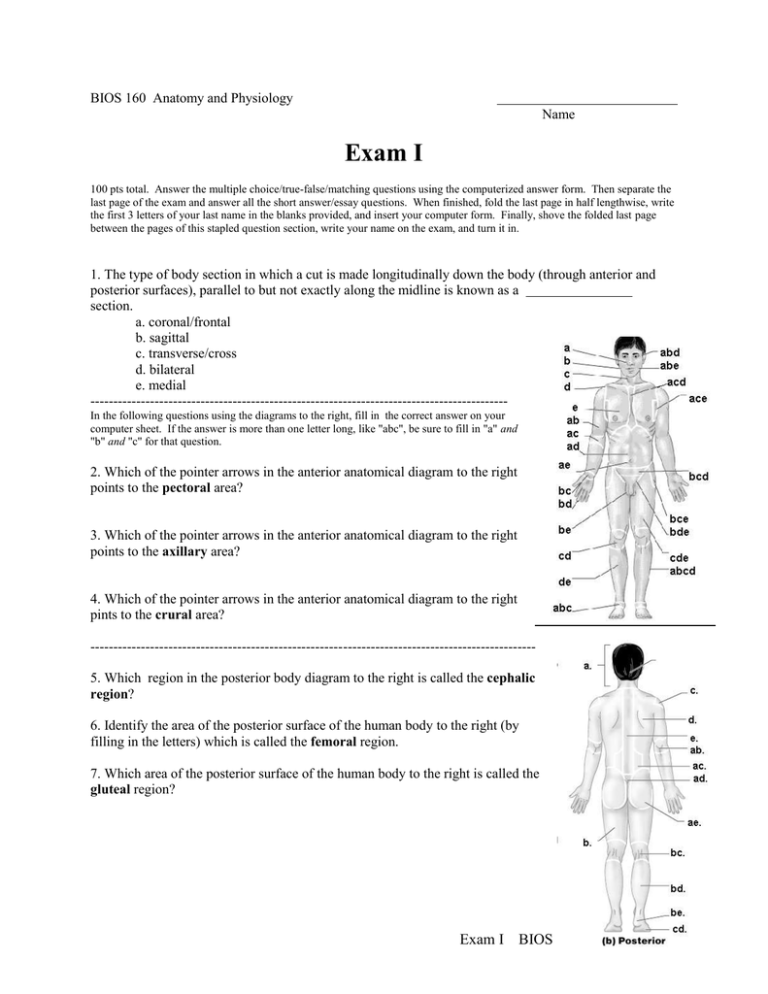
BIOS 160 Anatomy and Physiology Name Exam I 100 pts total. Answer the multiple choice/true-false/matching questions using the computerized answer form. Then separate the last page of the exam and answer all the short answer/essay questions. When finished, fold the last page in half lengthwise, write the first 3 letters of your last name in the blanks provided, and insert your computer form. Finally, shove the folded last page between the pages of this stapled question section, write your name on the exam, and turn it in. 1. The type of body section in which a cut is made longitudinally down the body (through anterior and posterior surfaces), parallel to but not exactly along the midline is known as a section. a. coronal/frontal b. sagittal c. transverse/cross d. bilateral e. medial ------------------------------------------------------------------------------------------In the following questions using the diagrams to the right, fill in the correct answer on your computer sheet. If the answer is more than one letter long, like "abc", be sure to fill in "a" and "b" and "c" for that question. 2. Which of the pointer arrows in the anterior anatomical diagram to the right points to the pectoral area? 3. Which of the pointer arrows in the anterior anatomical diagram to the right points to the axillary area? 4. Which of the pointer arrows in the anterior anatomical diagram to the right pints to the crural area? ------------------------------------------------------------------------------------------------5. Which region in the posterior body diagram to the right is called the cephalic region? 6. Identify the area of the posterior surface of the human body to the right (by filling in the letters) which is called the femoral region. 7. Which area of the posterior surface of the human body to the right is called the gluteal region? Exam I BIOS 160 pg 1 8. The cellular membrane of a body cell may have channels in which there is a cytoplasmic connection to an adjacent cell through which chemicals can flow. Such junctions are known as: a. gap junctions b. desmosomes c. tight junctions d. loose junctions e. extracellular space 9. The movement of water across a biological membrane follows the physical laws of: a. active transport b. passive diffusion c. facilitated diffusion d. endocytosis e. exocytosis 10. The role of the nucleolus in eukaryotic cells is to: a. transcribe rRNAs and assemble ribosomes b. transcribe mRNAs for cytoplasmic translation c. encircle and protect the chromatin d. limit transport of molecules into and out of the nuclear membrane e. conduct proteins through the cell to certain destinations -----------------------------------------------------------------------------------------------------------------------TRUE/FALSE QUESTIONS Answer "a" if true and "b" if false. 11. Microtubules are made up of a polymer of actin protein units. 12. Most of the readily available energy in an ATP molecule resides in the bond between the second and third of three phosphates connected together in a chain. 13. The knee is medial to the thigh. 14. A first degree burn is identified by a red and swollen area; sunburn is an example. 15. The basic units of nucleic acids are called amino acids. -------------------------------------------------------------------------------------------------------------------------16. The heart is ____________ to the sternum. a. proximal b. deep c. lateral d. medial e. superficial 17. Which of the following structures contains transitional epithelium? a. trachea b. kidney c. small intestine d. heart e. bladder Exam I BIOS 160 pg 2 18. The parietal layer found around the organs of the abdominal cavity is part of what structure? a. serous membrane b. meninge c. endocardium d. mucus membrane e. stratum germinativum (basale) 19. The function of the structure labeled ae in the skin diagram to the right is: a. sweat production b. sebum production c. sensing pain d. sensing pressure e. growing new epidermal cells 20. The deepest cells of layer b, just superficial to layer c, would best be called: a. stratum corneum b. stratum germinativum (basale) c. dermis d. stratum spinosum e. lamina propria 21. Which arrow in the skin diagram points to an eccrine sweat gland? (Note: if the answer is more than one letter – like “ae” – , fill in all of the letters on the same line on your answer sheet for this question). ---------------------------------------------------------------------------------------------------------------------22. Which is the correct sequence that new cells move through in the skin? a. stratum lucidum, stratum granulosum, stratum spinosum, stratum basale, stratum corneum b. stratum basale, stratum granulosum, stratum corneum, stratum spinosum, stratum lucidum c. stratum basale, stratum spinosum, stratum granulosum, stratum lucidum, stratum corneum d. stratum spinosum, stratum granulosum, stratum basale, stratum corneum, stratum lucidum e. stratum lucidum, stratum basale, stratum corneum, stratum granulosum, stratum spinosum 23. The function of a chondrocyte is to: a. phagocytize dead cells b. produce the cartilaginous matrix c. produce fatty acids d. produce a brown pigment e. store fat 24. The tissue shown in the micrograph to the right was found cushioning the eyeball. This tissue is: a. blood b. skeletal muscle c. cuboidal epithelium d. adipose tissue e. areolar connective tissue ---------------------------------------------------------------------------------------------------------------------------- Exam I BIOS 160 pg 3 25. The tissue shown in the picture to the right can be found in the spleen. It features a web-like array of collagen fibers. This tissue is: a. dense connective tissue b. reticular connective tissue c. blood d. osseous (bone) tissue e. hyaline cartilage 26. The term "lamina propria" describes: a. the layers of serous membranes around the lungs b. the basement membrane found under all epithelial tissues c. a layer of loose connective tissue under a mucous membrane d. the thin canals that connect the lacunae in bone tissue e. The layer between the epidermis and the dermis of the skin 27. The quick visual method of checking for malignant melanoma is known as the: a. ABCD Rule b. Rule of Nines c. Meal Times of the Day d. IPMAT Sequence e. OIL RIG Method 28. Which is the correct sequence (in the proper order) of the stages of skin tissue repair or regeneration? a. granulation tissue forms--> capillaries become permeable--> surface epithelium regenerates b. capillaries become permeable --> granulation tissue forms--> surface epithelium regenerates c. capillaries become permeable--> surface epithelium regenerates--> granulation tissue forms d. surface epithelium regenerates --> granulation tissue forms--> capillaries become permeable e. granulation tissue forms--> surface epithelium regenerates--> capillaries become permeable 29. The type of contractile tissue which is involuntary, not striated, and uninucleate is: a. adipose tissue b. skeletal muscle c. reticular tissue d. smooth muscle e. cardiac muscle 30. Which bone of the skull includes the styloid process? a. maxillary b. frontal c. sphenoid d. vomer e. temporal 31. Which of the following bone markings is a projection? a. fossa b. foramen c. process d. meatus e. fissure Exam I BIOS 160 pg 4 32. Which of the following sequences are in the correct order in time for how a broken bone repairs itself? a. hematoma formation-->fibrocartilage callus formation-->bony callus formation-->bone remodeling b. fibrocartilage callus formation-->bone remodeling-->hematoma formation-->bony callus formation c. bony callus formation-->bone remodeling-->hematoma formation-->fibrocartilage callus formation d. bone remodeling-->hematoma formation-->bony callus formation-->fibrocartilage callus formation e. hematoma formation-->bony callus formation-->fibrocartilage formation-->bone remodeling 33. Which of the following contains synovial fluid? a. ligaments b. joints c. tendons d. skeletal muscles e. smooth muscles 34. In the diagram to the right of a typical long bone, what type of tissue fills the interior space indicated by arrow c? a. spongy bone b. periosteum c. adipose d. articular cartilage e. endosteum de 35. The end-portion of a long bone as indicated by letter a in the bone diagram to the right is called the: a. body b. ball c. diaphysis d. epiphysis e. articular tuberosity 36. Which arrow in the bone diagram points to the endosteum? -----------------------------------------------------------------------------------------------------------------------37. The fibrous membranes connecting the cranial bones of a newborn infant are known as: a. ligaments b. fontanels c. hyaline cartilage d. conchae e. palatines Exam I BIOS 160 pg 5 ----------------------------------------------------------TRUE/FALSE QUESTIONS Answer "a" if true and "b" if false. 38. The second vertebra (C2) is known as the atlas. 39. There are 12 lumbar vertebrae. 40. In the medial view of the skull to the right, the parietal bone is indicated by arrow b. --------------------------------------------------------------------------------------------------------------------------- 41. In the diagram of the shoulder area to the right, what is the (scientific) name of the bone labeled "a"? a. clavicle b. radius c. ulna d. scapula e. humerus 42. In the diagram of the inside posterior portion of the skull, what structure is indicated by arrow "VI."? a. external auditory meatus b. lacrimal foramen c. foramen magnum d. crista galli e. occipital condyle Exam I BIOS 160 pg 6 BIOS 160 Exam I Short Answer Page Name 16 points total. When finished, remove and fold this last page in half lengthwise, write the first 3 letters of your last name in the blanks provided, and insert your computer form. Shove this folded last page between the pages of this stapled question section, write your name on the exam, and turn it in. A.. 2 pts. The part of cellular respiration in which electrons are indirectly used to build ATP (from ADP and Pi) is called the: -----------------------------------------------------------------------------------------------------------------------------B. 2 pts. The region in the diagram to the right specifically labeled "c" is called the ___________________ cavity. C. 2 pts. The space that includes both structures "a" AND "b" shown in the body cavity diagram to the right is known collectively as the ________ cavity. D. 2 pts. The structure in the body cavity diagram labeled "d" is known as the _ . ----------------------------------------------------------------------------------------------------------- E. 2 pts. One parameter that affects the activity of an enzyme is the __________ of the environment around that enzyme. F. 2 pts. The tissue type shown in the picture to the right which lies between the vertebrae is known as . G. 4 pts. The four types of bones in the skeletal system are long, short, and _____ _ bones. Exam I BIOS 160 pg 7 First three letters of last name Exam I BIOS 160 pg 8
